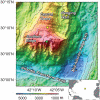First investigation of the microbiology of the deepest layer of ocean crust
- PMID: 21079766
- PMCID: PMC2974637
- DOI: 10.1371/journal.pone.0015399
First investigation of the microbiology of the deepest layer of ocean crust
Abstract
The gabbroic layer comprises the majority of ocean crust. Opportunities to sample this expansive crustal environment are rare because of the technological demands of deep ocean drilling; thus, gabbroic microbial communities have not yet been studied. During the Integrated Ocean Drilling Program Expeditions 304 and 305, igneous rock samples were collected from 0.45-1391.01 meters below seafloor at Hole 1309D, located on the Atlantis Massif (30 °N, 42 °W). Microbial diversity in the rocks was analyzed by denaturing gradient gel electrophoresis and sequencing (Expedition 304), and terminal restriction fragment length polymorphism, cloning and sequencing, and functional gene microarray analysis (Expedition 305). The gabbroic microbial community was relatively depauperate, consisting of a low diversity of proteobacterial lineages closely related to Bacteria from hydrocarbon-dominated environments and to known hydrocarbon degraders, and there was little evidence of Archaea. Functional gene diversity in the gabbroic samples was analyzed with a microarray for metabolic genes ("GeoChip"), producing further evidence of genomic potential for hydrocarbon degradation--genes for aerobic methane and toluene oxidation. Genes coding for anaerobic respirations, such as nitrate reduction, sulfate reduction, and metal reduction, as well as genes for carbon fixation, nitrogen fixation, and ammonium-oxidation, were also present. Our results suggest that the gabbroic layer hosts a microbial community that can degrade hydrocarbons and fix carbon and nitrogen, and has the potential to employ a diversity of non-oxygen electron acceptors. This rare glimpse of the gabbroic ecosystem provides further support for the recent finding of hydrocarbons in deep ocean gabbro from Hole 1309D. It has been hypothesized that these hydrocarbons might originate abiotically from serpentinization reactions that are occurring deep in the Earth's crust, raising the possibility that the lithic microbial community reported here might utilize carbon sources produced independently of the surface biosphere.
Conflict of interest statement
Figures



Similar articles
-
Microbial community stratification controlled by the subseafloor fluid flow and geothermal gradient at the Iheya North hydrothermal field in the Mid-Okinawa Trough (Integrated Ocean Drilling Program Expedition 331).Appl Environ Microbiol. 2014 Oct;80(19):6126-35. doi: 10.1128/AEM.01741-14. Epub 2014 Jul 25. Appl Environ Microbiol. 2014. PMID: 25063666 Free PMC article.
-
Diversity of prokaryotes and methanogenesis in deep subsurface sediments from the Nankai Trough, Ocean Drilling Program Leg 190.Environ Microbiol. 2004 Mar;6(3):274-87. doi: 10.1111/j.1462-2920.2004.00568.x. Environ Microbiol. 2004. PMID: 14871211
-
Prokaryotic diversity, distribution, and insights into their role in biogeochemical cycling in marine basalts.ISME J. 2009 Feb;3(2):231-42. doi: 10.1038/ismej.2008.92. Epub 2008 Oct 9. ISME J. 2009. PMID: 18843298
-
Functional gene surveys from ocean drilling expeditions - a review and perspective.FEMS Microbiol Ecol. 2013 Apr;84(1):1-23. doi: 10.1111/1574-6941.12051. Epub 2013 Jan 7. FEMS Microbiol Ecol. 2013. PMID: 23228016 Review.
-
Under the sea: microbial life in volcanic oceanic crust.Nat Rev Microbiol. 2011 Sep 6;9(10):703-12. doi: 10.1038/nrmicro2647. Nat Rev Microbiol. 2011. PMID: 21894169 Review.
Cited by
-
Microbial diversity in the deep-subsurface hydrothermal aquifer feeding the giant gypsum crystal-bearing Naica Mine, Mexico.Front Microbiol. 2013 Mar 6;4:37. doi: 10.3389/fmicb.2013.00037. eCollection 2013. Front Microbiol. 2013. PMID: 23508882 Free PMC article.
-
Microorganisms persist at record depths in the subseafloor of the Canterbury Basin.ISME J. 2014 Jul;8(7):1370-80. doi: 10.1038/ismej.2013.250. Epub 2014 Jan 16. ISME J. 2014. PMID: 24430485 Free PMC article.
-
A microarray for assessing transcription from pelagic marine microbial taxa.ISME J. 2014 Jul;8(7):1476-91. doi: 10.1038/ismej.2014.1. Epub 2014 Jan 30. ISME J. 2014. PMID: 24477198 Free PMC article.
-
Microbial Inventory of Deeply Buried Oceanic Crust from a Young Ridge Flank.Front Microbiol. 2016 May 27;7:820. doi: 10.3389/fmicb.2016.00820. eCollection 2016. Front Microbiol. 2016. PMID: 27303398 Free PMC article.
-
The rocky road to organics needs drying.Nat Commun. 2023 Jan 21;14(1):347. doi: 10.1038/s41467-023-36038-6. Nat Commun. 2023. PMID: 36681679 Free PMC article.
References
-
- Schrenk MO, Huber JA, Edwards KJ. Microbial Provinces in the Subseafloor. Annu Rev Mar Sci. 2010;2:279–304. - PubMed
-
- Delacour A, Früh-Green GL, Bernasconi SM, Schaeffer P, Kelley DS. Carbon Geochemistry of Serpentines in the Lost City Hydrothermal System (30 °N, MAR). Geochim Cosmochim Ac. 2008;72:3681–3702.
-
- Proskurowski G, Lilley MD, Seewald JS, Früh-Green GL, Olson EJ, et al. Abiogenic Hydrocarbon Production at Lost City Hydrothermal Field. Science. 2008;319:604–607. - PubMed
-
- Berndt ME, Allen DE, Seyfried WE., Jr Reduction of CO2 during serpentinization of olivine at 300°C and 500 bar. Geology. 1996:351–354.
-
- Janecky DR, Seyfried WE., Jr Hydrothermal serpentinization of peridotite within the oceanic crust: Experimental investigations of mineralogy and major element chemistry. Geochim Cosmochim Ac. 1986;50:1357–1378.
Publication types
MeSH terms
Substances
Associated data
- Actions
- Actions
- Actions
- Actions
- Actions
- Actions
- Actions
- Actions
- Actions
- Actions
- Actions
LinkOut - more resources
Full Text Sources
Other Literature Sources
Molecular Biology Databases

